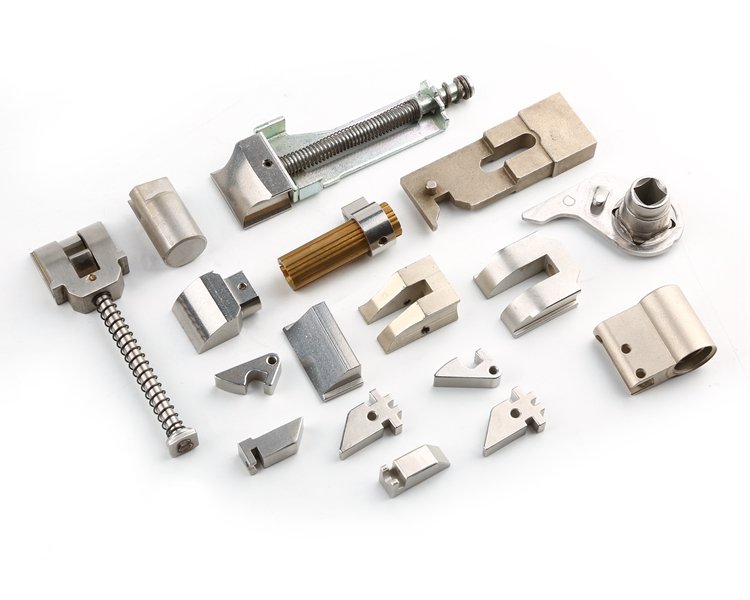Here is a detailed explanation of powder metal parts, from the basic concept to their advantages and common applications.

What Are Powder Metal Parts?
In simple terms, powder metal (PM) parts are components made by forming metal powders into a specific shape and then heating (“sintering”) them to bond the particles together without melting the metal entirely.
Think of it like baking a cake:
- You mix the ingredients (metal powders).
- You press the mix into a mold to get the desired shape.
- You bake it in an oven (sintering) to solidify it.
This process is formally known as Powder Metallurgy.
How Are They Made? The Basic Process
The manufacturing process involves several key steps:
- Powder Production: Metal powders are created. Common methods include atomization (where molten metal is broken up into tiny droplets that solidify into powder) or chemical reduction. The powders can be pure elements (like iron or copper) or pre-mixed alloys.
- Blending and Mixing: Different metal powders and additives (like a lubricant to aid pressing) are thoroughly blended to create a homogeneous mixture with the desired composition.
- Compaction: The blended powder is placed into a precision die (a mold) and pressed at high pressure (typically 10-50 tons per square inch). This “green compact” part holds its shape but is very fragile, like a chalk stick.
- Sintering: The green compact is placed in a controlled-atmosphere furnace and heated to a temperature below the melting point of the primary metal (typically 70-80% of the melting point). This heats the particles enough to fuse them at the contact points, dramatically increasing the part’s strength and integrity.
- Secondary Operations (Optional): Many PM parts are finished and ready after sintering. Others may undergo additional processes like:
- Sizing/Coining: Repressing to improve dimensional accuracy.
- Heat Treating: To increase surface hardness.
- Impregnation: Filling the pores with oil for self-lubrication.
- Machining: For adding features that can’t be pressed.
- Plating or Coating: For corrosion resistance or appearance.
Key Advantages of Powder Metallurgy
PM is chosen over other manufacturing methods (like casting, forging, or machining) because it offers unique benefits:
- Material Efficiency (Near-Net Shape): This is the biggest advantage. The part is formed to its final shape with minimal waste, often exceeding 97% material utilization. This is far more efficient than machining, where a large portion of the material is cut away as chips.
- High Dimensional Accuracy and Repeatability: The process produces parts with consistent and precise dimensions, often eliminating the need for further machining.
- Complex Shapes: It can create complex geometries that would be difficult or impossible to achieve economically with other methods (e.g., internal gears, complex multi-level parts).
- Controlled Porosity: The porosity (tiny voids between particles) can be precisely controlled. This is essential for:
- Self-lubricating bearings: Porosity is filled with oil, which seeps out during operation.
- Filters: For controlling fluid or gas flow.
- Unique Material Combinations: PM can combine metals that are immiscible (don’t alloy) in liquid state (e.g., tungsten and copper in electrical contacts). It can also create metal matrix composites.
- Cost-Effectiveness for High Volume: While the initial tooling (dies) can be expensive, the per-part cost is very low for large production runs, making it ideal for automotive and appliance applications.
Limitations
- High Initial Cost: The cost of tooling and presses is significant, making it less economical for very low-volume production.
- Size Limitations: Part size is limited by the press capacity. Very large parts are difficult to press uniformly.
- Inherent Porosity: While useful for some applications, porosity can reduce strength and ductility compared to a fully dense wrought or forged part. However, secondary processes can mitigate this.
- Design-Specific Tooling: Each new part shape requires a custom-designed and manufactured die.
Common Applications
You interact with powder metal parts every day, often without knowing it. They are ubiquitous in:
- Automotive Industry: The largest consumer of PM parts. Examples: engine connecting rods, transmission gears and clutches, oil pump gears, camshaft sprockets, shock absorber parts, and valve guides.
- Appliances: Gears in washing machines, vacuum cleaners, and power tools.
- Hardware and Recreation: Lock components, hand tool parts, and bicycle gears.
- Industrial Machinery: Bearings, bushings, filters, and structural components.
- Aerospace and Defense: High-temperature alloys for turbine blades, and heavy alloy components for inertial systems.
- Medical: Porous implants (like knee and hip replacements) that allow bone tissue to grow into the metal.
In summary, powder metal parts are precision components made from metal powder, offering a highly efficient, cost-effective, and versatile manufacturing method for producing complex, high-volume metal parts with minimal waste.
